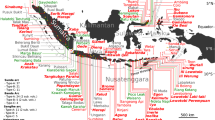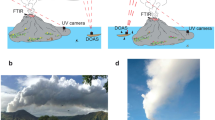Abstract
REMOTE sensing of SO2 emitted by Mount Etna in its normal state of permanent activity, indicates much higher flow-rates than those previously measured by the same method (correlation spectrometry) on other volcanoes. A set of measurements in June 1975 provided a mean SO2 flow-rate of 3,740 t d−1 for this volcano. This is a striking result both for volcanology and for environmental sciences. The knowledge of the mass discharge of chemical species from an active volcano and of its variations, both in time and space, is of great interest for the understanding of eruptive mechanisms and the establishment of geochemical balances. The SO2 content of a volcanic plume can be measured from a distance by an optical correlation technique; this method was perfected a few years ago and has since been widely used for the remote sensing of air pollution in industrial areas1. During June 1975, we used the correlation spectrometer Barringer Cospec II to measure the SO2 emitted by the active vents in the summit of Mount Etna (Central Crater, Bocca Nuova, North-East Crater and 1964 Crater), 3,200 m above sea level.
This is a preview of subscription content, access via your institution
Access options
Subscribe to this journal
Receive 51 print issues and online access
$199.00 per year
only $3.90 per issue
Buy this article
- Purchase on Springer Link
- Instant access to full article PDF
Prices may be subject to local taxes which are calculated during checkout
Similar content being viewed by others
References
Moffat, A. J. & Millan, M. M. Atmos. Environ. 5, 677–690 (1971).
Caddle, R. D., Wartburg, A. F. & Grahek, F. E. Geochim. cosmochim. Acta 35, 503–507 (1971).
Le Guern, F. Comptes R. D. 275, 1867–1869 (1972).
Sabroux, J. C. thesis, Univ. Paris VI, (1974).
Moore, J. G. & Fabbi, B. P. Contr. Mineral. Petrol. 33, 118–127 (1971).
Okita, T. Japan Spectroscopic Co. Rep. (Tokyo, 1971).
Moffat, A. J., Kakara, T., Akitomo, T. & Langan, L. Air Note, Environ. Measurements Inc. (San Francisco, 1972).
Stoiber, R. E. & Jepsen, A. Science 182, 577–578 (1973).
Okita, T. & Shimozuru, D. Bull. volcanol. Soc. Japan 19, 151–157 (1975).
Stoiber, R. E. & Malone, G. B. Trans. Am. geophys. Union 56, 461 (1975).
Anderson, A. T. Geol. Soc. Am. Bull. 85, 1485–1492 (1974).
Author information
Authors and Affiliations
Rights and permissions
About this article
Cite this article
HAULET, R., ZETTWOOG, P. & SABROUX, J. Sulphur dioxide discharge from Mount Etna. Nature 268, 715–717 (1977). https://doi.org/10.1038/268715a0
Received:
Accepted:
Issue Date:
DOI: https://doi.org/10.1038/268715a0
This article is cited by
-
Eruptive and diffuse emissions of CO2 from Mount Etna
Nature (1991)
-
The environmental influence of a volcanic plume, a new technique of study, Mount Etna, sicily
Environmental Geology and Water Sciences (1989)
-
Melt inclusion investigation of the volatile behaviour in historic alkali basaltic magmas of Etna
Bulletin of Volcanology (1989)
-
Detailed record of SO2 emissions from Pu'u `O`o between episodes 33 and 34 of the 1983?86 ERZ eruption, Kilauea, Hawaii
Bulletin of Volcanology (1988)
-
Influence of Saharan dust on the rain acidity and atmospheric input to the Mediterranean
Nature (1986)
Comments
By submitting a comment you agree to abide by our Terms and Community Guidelines. If you find something abusive or that does not comply with our terms or guidelines please flag it as inappropriate.



